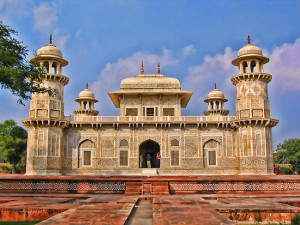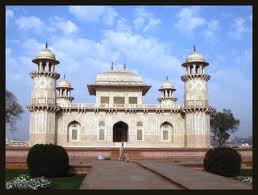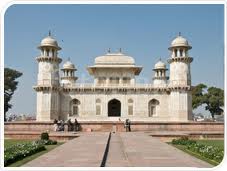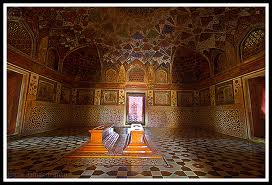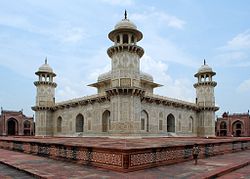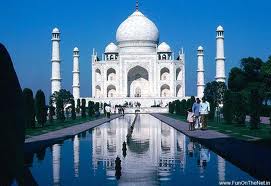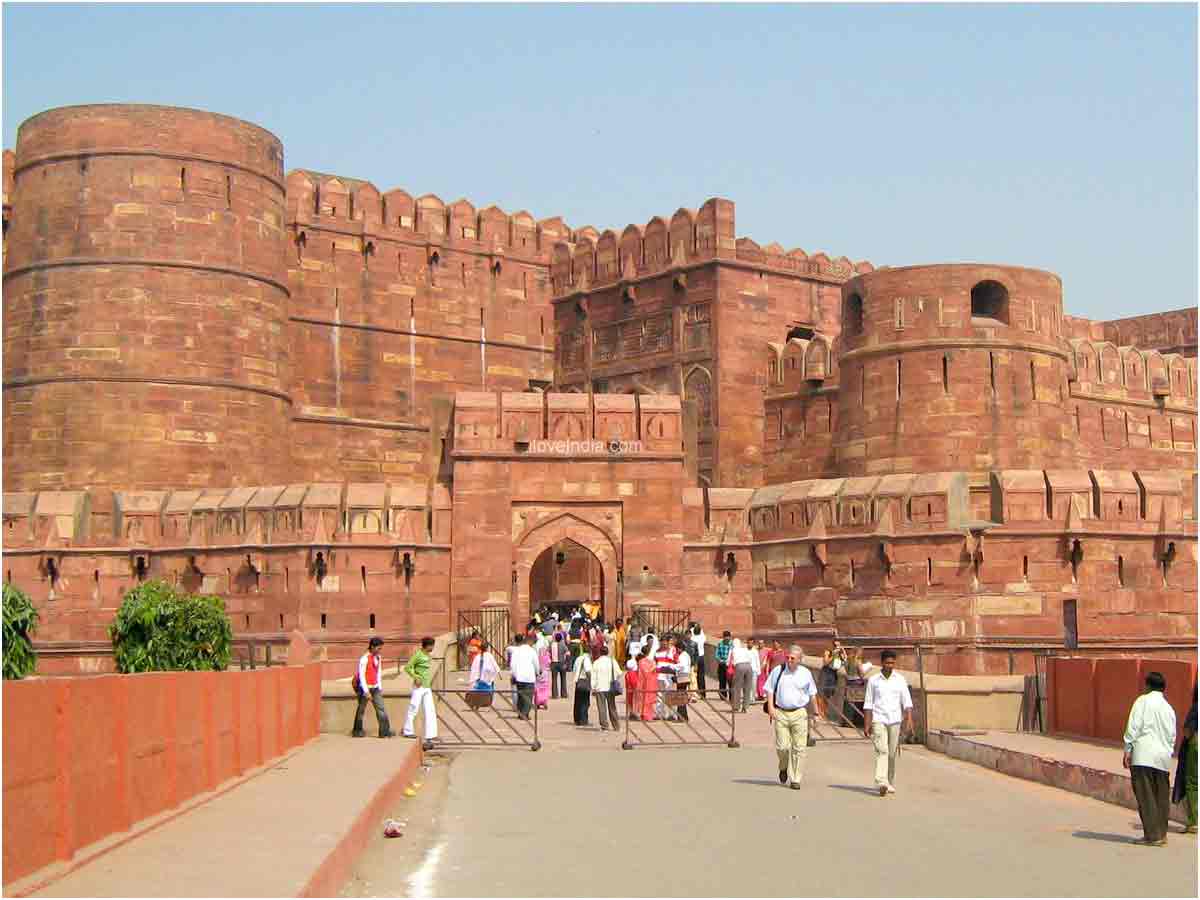India /Uttar Pradesh /Agra /Agra
Sight Address : Itimad-Ud-Daula’s Tomb lies on the bank of river Yamuna and some 2 km away from Ram-Bagh circle (NH2). Edit
Detail InformationEdit
Itimad-Ud-Daula’s Tomb, also known as the ‘Baby Taj’, is the first monument in India built entirely in marble. The tomb was built between 1622 and 1628 by the Queen of Jahangir, Nurjahan as a memorial to her father, Mirza Ghiyas Beg. Mirza Ghiyas Beg, an Imperial Officer, was bestowed with the title of Itmad-ud-Daulah (Pillar of State) by his Emperor Jahangir. The mausoleum rests in a walled garden close to the Yamuna River, approximately one and a half kilometers upstream of the Taj Mahal, Agra. This tranquil, small, garden was to inspire the construction of the Taj Mahal in the later years. Along with the main building, the structure consists of numerous outbuildings and gardens. It is a pure white and elaborated carved tomb that conforms to the Islamic style of architecture. It houses the cenotaph of Mirza Ghiyas Beg and Nurjahan’s mother Asmat Begum that resembles a jewel box and is set in a garden side by side. The adjacent chamber has the tombs of the other members of the family.
HistoryEdit
Itmad-Ud-Daula has a special place in the chronicles of both history as well as architecture. This is precisely because Itmad ud Daula is the very first tomb in India that is entirely made out of Marble. This is actually a mausoleum that overlooks the River Yamuna and is a tomb of Mir Ghiyas Beg, a minister in the court of Shah Jahan. The story of Itmad-Ud-Daula is an inspirational rag to riches saga. The tomb of Itimad-Ud-Daulah is as interesting as the life of the person for whom it was built. Mirza Ghiyas-Ud-Din or Ghiyas Beg (later known as Itimad-Ud-Daulah) was a poor merchant and lived in Persia modern-day Iran). His wife gave birth to a daughter whom he wanted to abandon for he has no money to feed her but the persistent wails of the infant changed his heart. The baby girl brought a stroke of good luck to her parents, for Ghiyas Beg found a caravan that straight way took him to the court of the great Mughal Emperor, Akbar. . After Akbar’s death in 1605, his son Jahangir became the Mughal emperor, who made Ghiyas Beg his chief minister or Wazir. Ghiyas Beg was also honoured with the title of Itimad-Ud-Daulah or the pillar of the state.Jahangir fell in love with his widowed daughter who processes unspeakable beauty. She was later christened Noor Jahan and went down in the history as one of the most beautiful and artistically gifted women in the world. Jahangir conferred the title of Itmad-Ud-Daula or ‘Pillar of the Empire’ to his father-in-law. Noor Jahan ordered the tomb after the death of her father in 1622.
Must SeeEdit
Popular
Visiting TimeEdit
6.00 AM to 6.00 PM
Closed OnEdit
N.A.
Best Season to VisitEdit
The tomb can be visited any time of the year. Though, the best time to visit Agra is between November and March when the weather is cool and conducive.
Best Time To VisitEdit
Morning, Afternoon, Evening.
Time Required for SightseeingEdit
1-2 hrs.
Ticket Required : Yes Edit
Individual National Adult Rs. : Rs 10
Kids Rs. : Children below 15 years of age are allowed free entry.
Individual Foreigner Adult Rs. : Rs 110
Kids Rs. : Children below 15 years of age are allowed free entry.
Still Photo Camera Rs. : N.A.
Video Camera Rs. : N.A.
Guide Required : No Edit
Approximate cost: N.A.
Dress Code (If Any) : No Edit
Dress Require: N.A.
Restaurants NearbyAdd / Edit
- Mango Suites Ascent – Agra ; Block No 66 & 73 NH-2, Delhi-Agra Road, Next to Dawar Industries, Agra, Uttar Pradesh, 282007 India ; Ph/M – 1860 500 2121 ; Food Serve – Continental cuisines.
How to ReachEdit
Taxi : This place of Agra is well connected by road and is easily accessible by taxis. Local taxis are also available at a reasonable rate.
Bus : Bus services in Agra are provide by Agra Municipal Corporation. UP State Road Transport Corporation does run some air-conditioned and non-air-conditioned low-floor buses within Agra which run on specific routes including M G Road.
Train : Agra is a major railway junction and has several railway stations, with the Agra Cantonment Railway station being the main one. Indian Railways connects Agra with all major and minor cities in India. The hired taxi, tempo, cycle-rickshaw and auto-rickshaw will helps tourist to reach her. Prepaid autos and taxis from railway station are easily available.
Air : Agra’s Kheria Airport is located 8 km away from the heart of the city. It will cost about Rs 150 from airport to city by taxi. Agra is connected to Varanasi, Delhi and Khajuraho by air. For other cities, tourists need to take the flight to Delhi. After getting down at Kheria airport taxis and tongas are available at the airport to reach this destination.
Others : Travelling around the town of Agra can be done through a multitude of ways, including electric buses, Tongas, tempos, cycle rickshaws and auto rickshaws.
Cycle Rickshaw:
Cycle rickshaws are available aplenty in the town of Agra. Travelling through a cycle rickshaw can be quite time consuming, although this is a very cheap mode of travel with charges hovering around Rs 5 to 10.
Tonga:
Tongas are horse drawn carriages that run throughout the town. Tonga charges are very low too, and you can opt for a Tonga ride as it is faster than a cycle rickshaw ride. Charges will range around Rs 5 to 15.
Tempo :
Tempos are also available, and these are shared vehicles which can be more comfortable than buses for slightly elevated rates. Tempo rates will vary from Rs 5 to 10. These are a safe mode of travel and can be taken up during night time.
Things to CarryEdit
Carry drinking water, camera, sunglasses & a hat or shades for protection from the harsh Sun.
Safety / WarningEdit
During winters make sure to travel with proper woollen clothes as nights in Agra is pretty chilling during winter. Do not accept any type of food from strangers while travelling on trains and buses.
HelplineEdit
Police 100
Ambulance 102
Fire Brigade 101
Tourist Information & Assistance 1364
